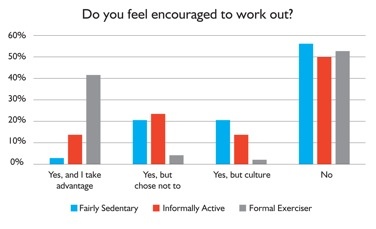- What's New
- Pricing & Purchasing
- Lead Times
- Literature & Samples
- Services & Warranties
- Careers
- Find a Rep
Employee Health – Is Your Corporate Wellness Program Enough?

Corporate wellness. It’s the hot topic in board rooms and human resource departments across the country. While it pains me to say that wellness is a trend, a number of startling facts are forcing employers to take notice and review their organizational goals and efforts when it comes to employee health and wellness.
One-third of U.S. adults are now considered obese. We have a sedentary office culture where the majority of workers sit all day. They then go home and continue that sedentary behavior. In a nutshell, we’ve stopped moving, which is greatly impacting our overall health. It’s estimated that poor employee health amounts to $147 billion in medical costs a year. Who carries the brunt of that cost? Employers!
These stats are driving the adoption of corporate wellness programs nation-wide. The Society for Human Resource Management estimates that in 2015, 80% of employers offered wellness services and education. For employers with over 200 employees, that percentage rose to 92%.
Wellness programs run the gamut. Some organizations simply provide ongoing education around healthy habits, while others go so far as to incentive healthy choices. Employees may even participate in yearly health screenings with insurance premiums dependent upon personal health scores.
The benefits of wellness programs are undeniable but are they enough to fully combat poor health?
There is conflicting evidence that these programs may not really incite the change expected, ultimately affecting the expected ROI of these programs. There are caveats.
Studies in the field of inactivity research challenge the belief that simply encouraging a healthy diet and exercise is sufficient to achieve employee wellness. Sedentary behavior, even in small increments, is harmful, and the office has become an incubator for sedentary behavior.
Additionally, while organizations may offer wellness programs, many employees do not feel that they have the support of their employer's to use the resources offered. When KI surveyed over 100 office employees, a startling majority said they did not feel encouraged to work out!

So what can organizations do if wellness programs aren’t enough?
It’s time to rethink the design of our workplaces. That’s where the principles of Active Design come in. In addition to a comprehensive wellness program, Active Design guides organizations as they plan for, and promote employee movement through office design. Simple changes like offering height-adjustable worksurfaces or allowing employees to work outdoors can impact health and well-being.
KI has identified nine principles/best practices that can help accomplish effective Active Design, while combating sedentary office behaviors. The nine principles include:
Principles of Active Design
- Implement Daylighting
- Create a Variety of Work Spaces
- Encourage Face-to-Face Communications
- Offer Healthy Food Options
- Encourage Movement at Work
- Design Flexible, Open Multi-Use Spaces
- Subconsciously Incite People to Take Stairs
- Incorporate Height-Adjustable Worksurfaces
- Allocate Outdoor Workspace
Each principle has a different level of complexity for implementation but the goal is the same, to get employees up and moving.
For instance, healthy food options and accessible café spaces encourage employees to make better choices while getting them away from their desks. Staircases that are visually appealing and centrally located are an easy way to promote the use of stairs over escalators and elevators. Face-to-face communications and a variety of work spaces gives employees the freedom to choose where they work while increasing movement as they interact with coworkers.
Slight modifications to work environments can go a long way to supporting healthy habits in the office. To learn more about our research and the nine principles for Active Design, download our full white paper, "Understanding Active Design: The Rise of Human Sustainability".
Subscribe
Stay up to date with the latest trends and more.



